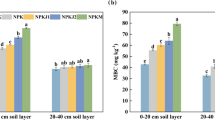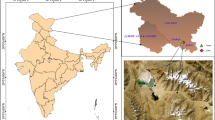Abstract
When numbers of microorganisms in profiles of surface and buried horizons on Mt. Kenya were estimated by dilution plate counting they were found to be consistently lower than those from other soils in different geographical regions as determined from the literature. The lower numbers are probably characteristic of the poorly weathered Inceptisols and Entisols usually found in the alpine zone.
The A horizons of the soils studied contain proportionately fewer of the total numbers of organisms in the A, B and C horizons than observed in most soils. Estimates of organic matter were positively correlated with numbers of fungi and bacteria in the A horizons. However, other factors such as severe drought, high light intensity, low temperatures, diurnal frost heaving, low pH and paucity of clay minerals may be significant factors in suppressing the more luxuriant growth of microbial populations.
Organic and inorganic horizons of buried soils sometimes exhibit higher counts of microorganisms than adjacent horizons of surface soils. However, the bacteria and fungi even in deeply buried paleosols exhibit characteristics of an unspecialized heterotrophic population. Among fungi the species were obviously the same as those isolated from one or more of the overlying horizons. Taken in conjunction with other evidence from the profiles it is concluded that the microorganisms were introduced and represent a transient or non-active population. Contamination of buried organic horizons may influence the estimated age as assessed by radiocarbon dating.
Similar content being viewed by others
References
Arshad M A, Meuria N K and Keya S O 1982 Effect of termite activities on the soil microflora. Pedobiologia 23, 161–166.
Baker B H 1967 Geology of the Mount Kenya Area. Geological Survey of Kenya. Rep. 79, 78 p.
Baker T H 1970 Yeasts moulds and bacteria from an acid peat on Signy Island. 717–722.In Antarctic Ecology Vol. 2. Holdgate, M W (Ed.) London Academic Press.
Birkeland P W 1974 Pedology, Weathering and Geomorphological Research. New York. Oxford Press, 285 p.
Boyd W L 1958 Microbiological studies of Arctic soils. Ecology 39, 332–336.
Boyd W L and Boyd J W 1964 The presence of bacteria in permafrost of the Alaskan Arctic. Can. J. Microbiol. 103, 917–919.
Clark F E 1967 Bacteria in soil. 15–49.In Soil Biology. Ecs. A Burges and F Raw. New York. Academic Press.
Coe M J 1967 The Ecology of the Alpine Zone of Mount Kenya. The Hague. Junk, 136 p.
Coetzee J A 1967 Pollen analytical studies in East and Southern Africa. Palaeoecology Africa 3, 1–146.
Fries E R and Fries Th C E 1948 Phytogeographical researches on Mt. Kenya and Mt. Aberdere, British East Africa. K. Svenska Vetensk. Akad. Handl. III, 25. Stockholm.
Hedberg O 1964 Features of Afroalpine Plant Ecology. Uppsala, Almquist and Wiksells.
Holding A J, Collins V G, French D D, D.Sylva B T and Baker J H 1974 Relationship between viable bacterial counts and site characteristics in tundra. pp 49–77.In Soil Organisms and Decomposition in Tundra. Eds. A J Holding, O W Heal, S F Machean Jr and P W Flanagan. Tundra Biome Steering Committee, Stockholm.
Keya S O, Mueria N K and Arshad M A 1982 Population dynamics of soil microorganisms in relation to proximity of termite mounds in Kenya. J. Arid Environ. 4, 1–8.
Kauri R 1978 Aerobic bacteria in the horizons of a beech forest soil. 110–112.In Microbiol Ecology Eds. M W Lautit and J Miles. Berlin, Springer Verlag.
Mahaney, W C 1972 Late Quaternary history of the Mount Kenya Afroalpine area. East Africa. Palaeoecology of Africa 6, 139–141.
Mahaney W C 1975 Reconnaissance Quarternary Stratigraphy of Mt Kenya. Palaeoecology of Africa, 6, 163–170.
Mahaney W C 1971 Soil erosion Along the Naro Moru track — A Western approach to Mount Keyna. East Africa Agric. For. 45, p 158–166.
Mahaney W C 1980 Late Quaternary rock glaciers, Mount Kenya, East Africa. J. Glaciology 25, 492–497.
Mahaney W C 1981 Paleoclimate reconstructed from paleosols: evidence from the Rocky Mountains and East Africa.In Quaternary Paleoclimate. Ed. W C Mahaney. Norwich, Geoabstracts. 227–247.
Mahaney W C 1982 Chronology of glacial deposits on Mount Kenya, East Africa: description of type sections. Palaeoecology of Africa 13, 25–43.
Mahaney W C 1982 Correlation of Quaternary glacial and periglacial deposits of Mount Kenya, East Africa with the Rocky Mountains of Western Wyoming, US 208.In XI INQUA Congress 1982, Abstracts.
Mahaney W C 1984 Radiometric dating of Quaternary glacial and nonglacial deposits, Mount Kenya, East Africa. National Geographic Society Research Report Series. (In press).
Mahaney W C 1984 The glacial and postglacial chronology of Mount Kenya, East Africa Palaeoecology of Africa 16, 327–341.
Mahaney W C and Sanmugades K 1983 Early Holocene soil catena in Titcomb Basin, Wind River Mountains, Western Wyoming. 27, 265–281.
McKeague J A 1978 Manual on Soil Sampling and Methods of Analysis. Can. Soc. Soil Sci. Ottawa.
Mishustin E N 1975 Microbial associations of soil types. Microb. Ecol. 2, 97–118.
Shulls W A and Mancinelli R L 1983 Comparative study of metabolic activities of bacteria in three ecoregions of the Colorado Front Range, USA. Arctic Alpine Res. 14, 53–58.
Soil Survey Staff 1951 Soil Survey Manual. U S Govt. Printing Office. Washington, 503.
Soil Survey Staff 1975 Soil Taxonomy, Agriculture Handbook 436. USDA Washington. 754 p.
Stephenson I L 1956 Some observations on the microbial activity in remoistened airdried soils. Plant and Soil 8, 170–182.
Stotzky G 1972 Activity, ecology and population dynamics of microorganisms in soil. Crit. Rev. Microbiol. 2, 59–137.
Timonin M I 1935 The microorganisms in profiles of certain virgin soils in Manitoba. Can. J. Res. 13C, 32–46.
Waksman S A 1963 Soil Microbiology. John Wiley and Sons. New York.
Widden P 1977 Microbiology and decomposition on Truelove Lowland. 505–530.In Truelove Lowland, Devon Island, Canada. A High Arctic Ecosystem. Ed. L C Bliss, University of Alberta Press, Edmonton.
Author information
Authors and Affiliations
Rights and permissions
About this article
Cite this article
Boyer, M.G., Mahaney, W.C. Some microbiological aspects of surface and buried soils on Mt. Kenya, East Africa. Plant Soil 86, 309–319 (1985). https://doi.org/10.1007/BF02145452
Received:
Revised:
Issue Date:
DOI: https://doi.org/10.1007/BF02145452




